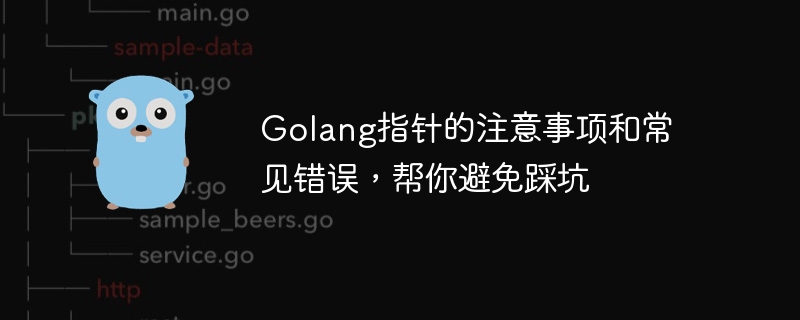

Precautions and common mistakes of Golang pointers to help you avoid pitfalls
In Golang, a pointer is a special data type that stores a variable the address of. Through pointers, we can directly access and modify the value stored at the corresponding address. Using pointers can improve program efficiency and flexibility, but it is also prone to errors. This article will introduce the precautions for Golang pointers and help you avoid possible pitfalls through specific code examples.
When we want to return a pointer, we must be careful not to return pointers to local variables. Because the local variable's memory is released when the function ends, returning its pointer will result in an invalid pointer reference.
Sample code:
func createPointer() *int {
i := 10
return &i // 错误!返回了局部变量的指针
}
func main() {
p := createPointer()
fmt.Println(*p) // 会导致编译错误或者运行时错误
}The correct approach is to use the new keyword or use the make function to create a pointer.
func createPointer() *int {
i := 10
return new(int) // 创建一个新的指针
}
func main() {
p := createPointer()
*p = 10
fmt.Println(*p) // 输出 10
}In Golang, a nil pointer is a null pointer, that is, a pointer that points to no valid address. When we dereference a nil pointer, it causes a runtime error.
Sample code:
func main() {
var p *int
fmt.Println(*p) // 运行时错误
}In order to avoid dereferencing a nil pointer, we can ensure that the pointer is valid by determining whether it is nil before using it.
func main() {
var p *int
if p != nil {
fmt.Println(*p)
} else {
fmt.Println("p is nil")
}
}In Golang, the type of pointers also needs to be paid attention to. Pointers of different types cannot be compared directly.
Sample code:
func main() {
var p1 *int
var p2 *int
if p1 == p2 { // 编译错误
fmt.Println("p1 和 p2 相等")
}
}In order to compare the values of pointers, we need to convert the pointers to the same type.
func main() {
var p1 *int
var p2 *int
if p1 == (*int)(unsafe.Pointer(p2)) {
fmt.Println("p1 和 p2 相等")
}
}When using pointers, be careful to avoid null references of pointers, that is, pointers do not point to valid memory addresses. If you use a null-referenced pointer for dereference or assignment, a runtime error will result.
Sample code:
func main() {
var p *int
*p = 10 // 运行时错误
}In order to avoid the null reference of the pointer, we can use the new keyword or the make function to create the pointer and assign the corresponding memory space.
func main() {
p := new(int)
*p = 10 // 指针指向了有效的内存地址
fmt.Println(*p) // 输出 10
}In Golang, when calling a function, parameters are passed by value. If the argument type is a pointer, a copy of the pointer is passed, not the pointer itself. This means that modifications to the pointer within the function will not affect the original pointer.
Sample code:
func modifyPointer(p *int) {
i := 10
p = &i
}
func main() {
var p *int
modifyPointer(p)
fmt.Println(p) // 输出空指针 nil
}In order to modify the value of a pointer inside a function, we need to pass a pointer to the pointer or use a reference to the pointer.
func modifyPointer(p *int) {
i := 10
*p = i
}
func main() {
var p *int
modifyPointer(&p)
fmt.Println(*p) // 输出 10
}Through the above precautions and sample code, I hope it can help you understand the use of Golang pointers and avoid common mistakes. When you use pointers correctly, they become a powerful tool in your programming, improving the efficiency and flexibility of your program.
The above is the detailed content of Avoid pitfalls: Precautions and common mistakes in mastering Golang pointers. For more information, please follow other related articles on the PHP Chinese website!




